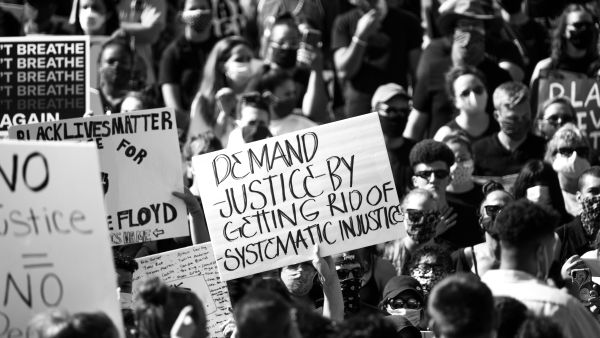Watching the news of Black Lives Matter protests erupting across the United States, we need to acknowledge that the injustices endured by black people throughout American history are much more than police violence and excessive use of force against them, it is quite financial too.
Historic and systematic oppression of people of color in the US, especially ones with African origins started as early as the US was discovered.
Most of today's Black Americans are descendants of more than 4 million slaves who were forcefully brought to North America onboard colonizers' ships with chains. Historic records show that King Charles I had issued a decision allowing Spain to ship enslaved people directly from Africa to America.
Slavery and Segregation
Until 1860, 89% of the black population of America were registered as slaves mostly working in cotton plantations and denied all elements of human rights.
Even after the end of the civil war that abolished slavery, African Americans had to live through long decades of segregation under Jim Crow laws, which had affected every aspect of their lives between the late 1800s to mid-1950s, depriving the vast majority of black people of education, employment, and even using the same public facilities enjoyed by white people.
Only through continuous efforts exerted by millions of African Americans throughout decades of the Civil Rights Movement, did they end explicit laws that discriminated against them and other minority groups. In 1965, they also won the right to vote, consequently granting it to other people of color.
Yet, racially charged practices against black people continued in US communities until this very day, although less straightforward, showing mostly in education, employment opportunities, health services, in addition to racial profiling often connected to police excessive use of force.
Population
In terms of the US population, African Americans make up 13.4% of Americans, nearing 40 million people.
Education
Until the 1960s, non-White Americans were barred from studying in most US universities and colleges under segregation laws and had to apply for exclusively black institutions instead, affecting the quality of education received by several generations of African Americans.
It wasn't until the 1990s that scores of black students at the Scholastic Aptitude Test (SAT) spiked by 54 points.
According to a 2017 U.S. Census Bureau survey, 28.3% of white Americans reported having finished high school compared to 33% of African Americans.
23.7% of white Americans had received their Bachelor's degree compared to 15% of black students. Similarly, white MA holders exceeded 10% while black MA holders neared 7%. Finally, only 2% of white Americans and 1.1% of black Americans reported earning a doctoral degree.
In 2015, African American women were the most educated group in terms of race and gender in the United States,
Employment
According to a 2018 Bureau of Labor Statistics report, 6.6% of Black Americans were reportedly unemployed, which is the highest rate amongst all racial groups in the United States.
In the wake of the Coronavirus crisis, Washington Post-Ipsos Coronavirus employment survey conducted between April and May 2020 found out that 16% of African Americans were laid off compared to 11% of White Americans.
Despite the fact the African American women are among the highest educated groups in the States, a recent study found that black women make up just 8% of private-sector jobs and only 1.5% of leadership roles, a 2016 Independent report highlights.
Even more startling, a study conducted by the National Bureau of Economic Research found that "despite laws against discrimination, affirmative action, a degree of employer enlightenment, and the desire by some businesses to enhance profits by hiring those most qualified regardless of race, African-Americans are twice as likely as whites to be unemployed and they earn nearly 25% less when they are employed."
Poverty Rate
According to US Census Data for 2018, 25.4% of Native Americans, 20.8% of African Americans and 17.6% of Hispanic Americans reported the highest poverty rates in the country, compared to 10.1% of White Americans.
Moreover, CNN's latest report on Black vs White Financial inequality noted that "the median income for black households is a little less than 60% of that of white households, based on 2018 census data."
Healthcare
During the Coronavirus pandemic that has killed more than 100k Americans so far, African Americans seemed to pay the highest toll.
APM Research Lab reported that Black Americans were 3 times more likely to die of COVID-19 than their white counterparts at a rate of 50.3 per 100,000 people, compared with 20.7 for whites.
This huge difference has been linked to their disadvantaged access to health services in addition to a large number of them working in essential jobs that were not stopped during lockdowns.
Wealth Gap
At the beginning of 2020, Forbes list of the world's billionaires' highlighted that of 607 American billionaires, only 5 are African Americans, all self-made artists, sports or media figures, or businessmen; Robert F. Smith, David Steward, Oprah Winfrey, Michael Jordan, and Jay-Z.
All of these figures clearly reflect that the long history of black oppression in the United States still shows in today's world. Unfortunately, these financial inequalities suffered by the African American community aren't the only obstacles they need to overcome in 2020.
In addition to a growing sentiment of racial prejudice against minorities since the 2016 presidential elections, African Americans have repeatedly reported different practices of voters' suppression, besides several criminal laws that seem to have been designed specifically to target people of color, which has often been dubbed as "the new Jim Crow laws," such as drug-related punishments carried out by law.
Today's Black Lives Matter could be the new Civil Rights Movement, addressing the different forms of injustices African Americans and other minorities experience in the United States, with the financial inequalities being at its very heart.







